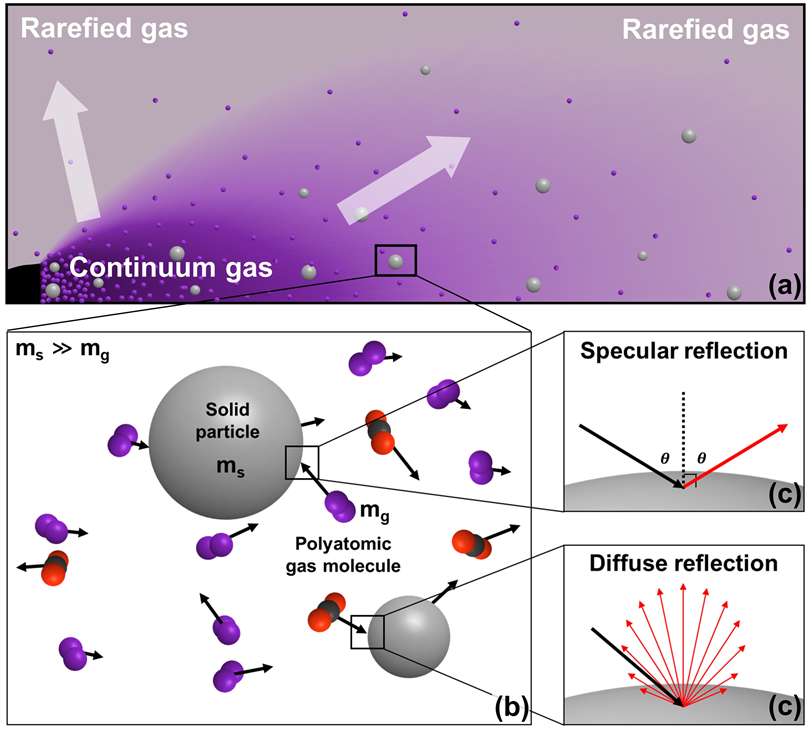Major research outcome
- MS. Candidate Yeongho Shin, Ph.D. Candidate Sanghun Kim, and Prof. Eunji Jun, An Approach for Multiscale Two-Phase Flow Simulation in the Direct Simulation Monte Carlo Framework
- 관리자 |
- 2024-06-28 17:33:14|
- 249
- 2024-06-28 17:33:14|
Numerical simulation of multiscale gas flows with solid particles has been studied in aerospace applications where accurate predictions are crucial for ensuring safety and efficiency. For example, phenomena such as solid rocket plumes at high altitudes and soft landings on dusty lunar surfaces involve complex physical phenomena that can significantly impact mission success. Due to the rarefied environments in these scenarios, traditional approaches based on continuum assumptions could fail to model these critical interactions accurately, highlighting the need for more advanced, particle-based simulation methods.
Within the Direct Simulation Monte Carlo (DSMC) framework, Burt's model has been widely used for predicting gas-solid interactions, based on the assumption that a solid particle diameter is much smaller than the local gas mean free path. This assumption, however, could be invalid, especially in continuum gas regions where the local gas mean free path tends to be smaller than it is in rarefied gas regions. This shows that Burt's model could be invalid in multiscale two-phase flow simulations.
To compensate for the limitation in Burt's model, this study introduces the Gas–Solid Synchronous (GSS) model, which predicts gas–solid interactions in continuum gas regions without assuming the local gas flow regime around a solid particle. Similar to Burt’s model, the GSS model includes gas-to-solid and solid-to-gas interaction models to consider bidirectional interaction between two phases. The GSS gas-to-solid model is established by selecting accurate semi-empirical force and heat transfer models, in comparison with DSMC simulation results. The GSS solid-to-gas model is developed based on the principles of momentum and energy conservation and validated against Burt’s solid-to-gas model. The results show that Burt’s model could overestimate the interphase force and heat transfer rates when its assumptions on solid particle diameter do not hold, but it can reproduce non-equilibrium characteristics of two-phase flows where gas velocity distribution functions do not follow the Maxwell–Boltzmann distribution. By contrast, the GSS model can accurately predict gas–solid interaction in continuum gas flows, while it cannot capture the non-equilibrium nature of two-phase flows. The characteristics and limitations of the two models indicate that using a valid model for each gas–solid interaction could be crucial for accurate simulation of multiscale two-phase flows.
This work has been published in the international journal 'Physics of fluids' (IF: 4.1). First author: Yeongho Shin, MS. candidate.
Title: An approach for multiscale two-phase flow simulation in the direct simulation Monte Carlo framework
https://doi.org/10.1063/5.0212766

그림: (a) Schematic diagram of multiscale gas flow with solid particles, (b) collisions between gas molecules and solid particles, and (c) Maxwell GSI model of a gas molecule on solid molecule on solid particle surfaces.
Within the Direct Simulation Monte Carlo (DSMC) framework, Burt's model has been widely used for predicting gas-solid interactions, based on the assumption that a solid particle diameter is much smaller than the local gas mean free path. This assumption, however, could be invalid, especially in continuum gas regions where the local gas mean free path tends to be smaller than it is in rarefied gas regions. This shows that Burt's model could be invalid in multiscale two-phase flow simulations.
To compensate for the limitation in Burt's model, this study introduces the Gas–Solid Synchronous (GSS) model, which predicts gas–solid interactions in continuum gas regions without assuming the local gas flow regime around a solid particle. Similar to Burt’s model, the GSS model includes gas-to-solid and solid-to-gas interaction models to consider bidirectional interaction between two phases. The GSS gas-to-solid model is established by selecting accurate semi-empirical force and heat transfer models, in comparison with DSMC simulation results. The GSS solid-to-gas model is developed based on the principles of momentum and energy conservation and validated against Burt’s solid-to-gas model. The results show that Burt’s model could overestimate the interphase force and heat transfer rates when its assumptions on solid particle diameter do not hold, but it can reproduce non-equilibrium characteristics of two-phase flows where gas velocity distribution functions do not follow the Maxwell–Boltzmann distribution. By contrast, the GSS model can accurately predict gas–solid interaction in continuum gas flows, while it cannot capture the non-equilibrium nature of two-phase flows. The characteristics and limitations of the two models indicate that using a valid model for each gas–solid interaction could be crucial for accurate simulation of multiscale two-phase flows.
This work has been published in the international journal 'Physics of fluids' (IF: 4.1). First author: Yeongho Shin, MS. candidate.
Title: An approach for multiscale two-phase flow simulation in the direct simulation Monte Carlo framework
https://doi.org/10.1063/5.0212766

그림: (a) Schematic diagram of multiscale gas flow with solid particles, (b) collisions between gas molecules and solid particles, and (c) Maxwell GSI model of a gas molecule on solid molecule on solid particle surfaces.
| 첨부파일 |
|---|


